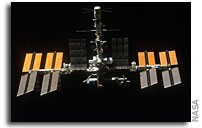NASA Space Station Lead Increment Scientist’s Highlights For the Week of July 30, 2012

(Highlights: Week of July 30, 2012) — Two biology experiments arrived at the station aboard the HTV-3. They were winners in the YouTube Space Lab global science contest. This contest challenges students to design an experiment to be conducted onboard the station. One winning experiment examines the antifungal properties of Bacillus subtilis. Another examines the predatory behavior of jumping spiders. So far, the spiders are responding well to the space environment. One has molted, which is normal. The spider experiment’s designer — a young man from Alexandria, Egypt — has given both female spiders names. Nefertiti is the redback jumping spider and Cleopatra is the zebra jumping spider.
Four tests were successfully completed for the Burning And Suppression of Solids (BASS) investigation. BASS examines the burning and extinction characteristics of a wide variety of fuel samples in microgravity. A crew member conducted flame tests at various air and gaseous nitrogen flows. These tests were run to determine if the flames would blow out at high flow rates. The BASS investigation will guide strategies for extinguishing accidental fires in microgravity. BASS results contribute to combustion computational models used in the design of fire detection and suppression systems in microgravity and on Earth.
An 18-day run ended with the DEvice for the study of Critical LIquids and Crystallization Alice Like Insert (DECLIC-ALI). These runs were dedicated to the observation of the boiling process when increasing the temperature. DECLIC-ALI studies liquids at the verge of boiling. The flow of heat during boiling events is different in microgravity than it is on Earth. Understanding how heat flows in fluids at the verge of boiling will help scientists develop cooling systems for use in microgravity. On Earth, the readily variable properties of near-critical fluids makes them appealing candidates for studying numerous interesting phenomena valid for all fluids, which will ultimately lead to the development of improved solvents for chemistry and the environment. The next sequence of tests is planned for September.
The final series of 14 runs were completed for the Japan Aerospace Exploration Agency-sponsored Chaos, Turbulence and its Transition Process in Marangoni Convection (Marangoni) experiment. This is one of two physics experiments analyzing the behavior of a surface-tension-driven flow in microgravity. The next set of runs is planned for Expedition 34.
Human research investigations continued for various crew members including, SPRINT, Journals, Vessel Imaging, Treadmill Kinematics, Integrated Cardiovascular, Pro K, Nutrition and Reaction Self Test .
John Love, Lead Increment Scientist Expedition 31/32









